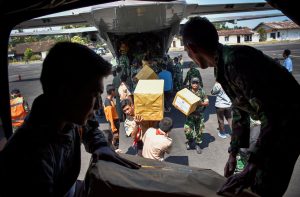
By Kanupriya Kapoor
PEMENANG, Indonesia (Reuters) – A magnitude 6.2 aftershock rocked Indonesia’s Lombok on Thursday, sparking fresh panic on the tropical tourist island as the official death toll from a powerful earthquake four days earlier almost doubled to 259.
Reuters witnesses reporting on the aftermath of Sunday’s quake in the north of the island said buildings and walls that had already been weakened collapsed, and people ran out onto roads even as rocks tumbled down from hillsides.
“Evacuees and people ran out of houses when they felt the strong shake of the 6.2 magnitude quake,” Sutopo Purwo Nugroho, a spokesman for Indonesia’s disaster mitigation agency (BNPB), said on Twitter. “People are still traumatized. Some buildings were damaged further because of this.”

People are seen running out of Bali’s Ngurah Rai International Airport, Indonesia August 9, 2018 in this still image taken from a video obtained from social media. DOY SAFANDO BALI/via REUTERS
Officials said the epicenter of the aftershock was on land and so there was no risk of a tsunami.
The United States Geological Survey recorded the latest quake at 5.9, at a depth of 10 km (six miles).
BNPB’s toll of verified deaths from Sunday’s 6.9 magnitude quake was raised on Thursday to 259 from 131.
“This number will continue increasing as rescue teams continue to find victims under collapsed buildings,” the agency said in a statement.
A humanitarian crisis is also looming in Lombok, where thousands have been left homeless and in desperate need of clean water, food, medicine and shelter.
Authorities made announcements over loudspeakers at evacuation sites, urging people to remain calm and stay inside tents or find open space if they were inside or near buildings.
“Please stay calm, this is just an aftershock and it will be over soon, there’s no need to be scared,” one official announced.
Officials said about three-quarters of Lombok’s rural north had been without electricity since Sunday, although power had since been restored in most areas before the aftershock. Aid workers have found some villages hard to reach because bridges and roads were destroyed.
Ruslan, a 29-year-old resident of Pemenang on the northwestern shoulder of Lombok, said he had already been anxious about aftershocks before the latest jolt.
“My heart jumps if even the door slams hard. It’s difficult to get used to,” he said. “We are still scared to go into the house. At the most we go in quickly to grab something and then run back out.”

Indonesian soldiers unload relief aid for earthquake victims from a plane at an airbase in Mataram, Lombok, Indonesia August 9, 2018 in this photo taken by Antara Foto. Antara Foto/Ahmad Subaidi/via REUTERS
Thousands of tourists have left Lombok since Sunday, fearing further earthquakes, some on extra flights provided by airlines and others on ferries to the neighboring island of Bali.
Indonesia sits on the Pacific Ring of Fire and is regularly hit by earthquakes. In 2004, the Indian Ocean tsunami killed 226,000 people in 13 countries, including more than 120,000 in Indonesia.
(Additional reporting by Bernadette Christina Munthe and Fransiska Nangoy in JAKARTA; Writing by John Chalmers; Editing by Nick Macfie)





